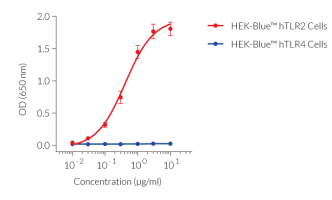Purified LTA-SA
-
Cat.code:
tlrl-pslta
- Documents
ABOUT
Lipoteichoic acid from S. aureus
Lipoteichoic acid (LTA) is a major immunostimulatory component of Gram-positive bacteria. Like LPS, LTA is an amphiphile formed by a hydrophilic polyphosphate polymer linked to a neutral glycolipid.
LTA stimulates immune cells through TLR2 to produce TNF-α and other inflammatory cytokines. Recognition of LTA involves also LPS-binding protein (LBP) and CD14.
InvivoGen provides LTA purified from S. aureus (LTA-SA) with the EndoFit™ grade (<0.001 EU/μg).
All products are for research use only, and not for human or veterinary use.
SPECIFICATIONS
Specifications
TLR2
1 ng -1 μg/ml for cellular assays
< 0.001 EU/μg (measurement by kinetic chromogenic LAL assay)
Cellular assays
Each lot is functionally tested and validated using HEK-Blue™ hTLR2 Cells.
CONTENTS
Contents
-
Product:Purified LTA-SA
-
Cat code:tlrl-pslta
-
Quantity:5 mg
10 ml of endotoxin-free water
Shipping & Storage
- Shipping method: Room temperature
- Upon receipt, store product at -20 °C
- Avoid repeated freeze-thaw cycles
Storage:
Caution:
DOCUMENTS
Documents
Technical Data Sheet
Safety Data Sheet
Certificate of analysis
Need a CoA ?




